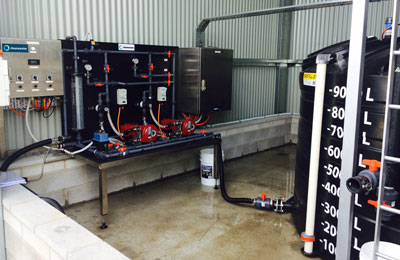What is pH control and where is it used?
pH is a measurement of the alkalinity or acidity of a substance. A pH level of 7 is neutral (e.g. water), while a pH above 7 is an alkaline substance and a pH below 7 is acidic.
pH control is the process of adding an alkaline or acidic substance to a liquid in order to bring the measured pH within a desired range. For example, most water authority regulators have specifications for the pH range of waste water that is discharged from commercial or industrial sites. For example, trade waste authorities generally require pH discharge limits to be within 6 to 10.
When it comes to accurate pH control systems, you can't go past Cleanawater. Our expert team can recommend, design, and install the correct solution for your business.
A pH controller consists of a probe to measure the current pH of the substance, chemicals to correct the pH via an injection pump, and a controller that calculates the required injection rate and activates the injection system.
There are different types of pH control systems:
- In-line pH control where a probe is inserted in the pipe through which the solution is flowing or in a tank holding the solution. The controller then adds chemicals directly to the solution via a connection into the pipe.
- Recirculating pH control where the solution is pumped from a tank to a measurement system and then returned to the tank. The stream is filtered, measured by the probe and chemicals are injected in its return path. This method is more accurate because it tests water currently in circulation, which improves the accuracy of the reading, and has less potential for damage to sensitive probes.

Commonly used chemicals for pH control are Sodium Hydroxide to raise the pH of acidic solutions or Hydrochloric acid to drop the pH of alkaline solutions.
When and where is pH control used?
Any commercial or industrial operation where waste water is generated commonly have a system for measuring and treating effluent water before it is discharged. pH is just one of the specifications that must be adhered to. Effluent water is subject to strict government agency controls and specifications, and violations can result in fines and prosecution as well as damage to the environment.
Depending on the amount of waste water generated, the treatment systems can be large and complex or compact and simple. The appropriate system must be designed and selected on the basis of how much injection chemical is needed and the accuracy required.

In addition, the pH of the effluent water can have an effect on the separation of other pollutants from the water. For example, pH correction is used in water treatment plants that are removing suspended solids from water. pH controllers are used to correct pH levels to a desired range to enable coagulants (chemicals that clump together small particle solids that would otherwise pass through mechanical filtration) to operate efficiently and bring particle solids in suspension together, and enable efficient removal from water.
Besides the management of effluent water, pH can also be an important parameter to control during some process operations. For example, fermentation usually occurs in an acidic pH range. Drinking water must be controlled within a range of 6.5 to 8.5. Public swimming pools need pH control to ensure the water is not harmful to swimmers. A pH close to 7.4 is ideal to prevent irritation to the skin. If the pH is too high, the water can also become cloudy giving the appearance of being dirty. pH control is therefore relevant in a large number of industries and applications.
Applications for pH Control
In terms of effluent pH control, some of the specific industry applications are as follows:
- Mining operations which generate acidic water that must be safely disposed of.
- Car Wash and Vehicle wash-down operations, where chemicals are used in the washing fluid and oil may be washed off the car engines into the sewer.
- Workshops where chemicals, lubricating oils, greases etc. used in maintenance tasks can be washed into the waste water
- Industrial sites where site specific contaminants must be controlled and mitigated through sewer control systems
- Service stations where cars may leak oil or spills may occur during refuelling.
- Quarantine wash bays where unknown contaminants may affect waste water quality.
Contact Cleanawater for more information about pH control
We offer highly technical expertise, excellent quality equipment and a personalised approach to your business’ needs. We can easily combine our solutions to suit your specific business, compliance and investment requirements.
Are you looking for an effective pH control system? Get in touch with Cleanawater for expert advice and unmatched industry knowledge.
Must Read
What to Expect During a Modular Wash Bay Installation
CleanaWater, we make the process of installing a modular wash bay on your site as smooth and straightforward as possible. ...
Read moreThe CleanaWater Team Driving Water Treatment and Sustainability
CleanaWater is powered by a dedicated team of professionals who bring expertise and passion to every project. ...
Read more